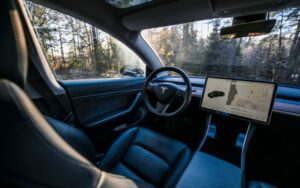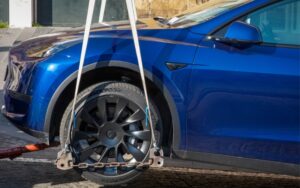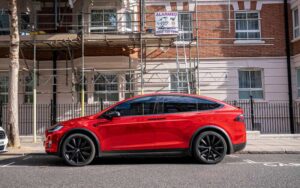This is How To Fix Tesla Panel Gaps!
Last updated on April 18th, 2023 at 11:16 pm
Regarding electric vehicles, none can beat Tesla. Its unique features and performance make it stand out.
However, panel gaps are an issue you may face with your vehicle. And these issues may lead to more serious issues over time.
Although tiny panel gaps shouldn’t be much cause for concern, wider gaps can indicate that your panel needs immediate repair.
This article will provide detailed information on fixing these panel gaps.
Various reasons can cause gaps in your Tesla’s panel. And you can fix these gaps by first cleaning the affected area. Then, gather the materials you need (sealants and adhesive). Afterward, apply the silicone sealant. Smoothen out the sealant while looking out for more gaps in the surrounding area. Allow to dry, and check your results.
Although fixing panel gaps on your Tesla might initially seem cumbersome, this detailed guide reduces any excess work that may prove too challenging.
By the end of this article, you’d have discovered a quicker and less challenging way to fix minor panel gap issues by yourself.
Can Panel Gaps be Fixed on a Tesla?

Yes, you can fix the panel gaps of your Tesla. Panel gaps are the spaces or misalignments between different body panels on a vehicle.
Various reasons, such as manufacturing variations and temperature changes, can cause your Tesla to develop these gaps.
Various factors, such as poor manufacturing, damage during shipping, or just natural settling over time, can cause these gaps.
But, if the panel gaps on your Tesla are noticeable and you would like to have them fixed, you can take your vehicle to a Tesla service center.
The technicians will assess the gaps and determine if they can fix your panel. In most cases, they can fix the panel gaps through adjustments or realignments of the affected panels.
If the gaps are significant and the technician can’t fix them through adjustments, replacement of the affected panel may be necessary.
It’s important to note that panel gaps are a normal part of vehicle construction and are not considered a defect.
Small variations in panel gaps are expected and don’t affect the performance or safety of the vehicle.
How do I Fix Panel Gaps on my Tesla?
Several factors can cause gaps in the panels of your Tesla vehicle, including misalignment during the manufacturing process, changes in temperature and humidity, or normal wear and tear.
Thus, here’s a step-by-step guide on fixing panel gaps on a Tesla vehicle:
#1. Clean the Affected Area
Before you start fixing the panel gap, make sure to clean the affected area thoroughly. This will ensure that no dirt or debris prevents the adhesive from sticking to the panel.
#2. Gather the Necessary Materials
You will need the following materials: a silicone adhesive sealant, a plastic spreader or putty knife, masking tape, and a clean cloth.
#3. Apply the silicone sealant
Apply the silicone sealant along the inside edge of the panel gap using the plastic spreader or putty knife. Make sure to apply enough silicone to fill the gap.
#4. Smooth Out the Silicone
Use the plastic spreader or putty knife to smooth out the silicone, ensuring you evenly distribute it along the gap.
#5. Protect Surrounding Areas
Use masking tape to protect the surrounding areas from the silicone sealant.
#6. Clean up Excess Silicone
If there’s any excess silicone, use a clean cloth to wipe it away before it dries.
#7. Allow the Silicone to Dry:
Next, allow the silicone to dry completely, which usually takes 24 hours.
#8. Check the Results
After the silicone has dried, check the results. If the gap is still visible, you may need to apply another silicone layer.
Here’s an easier and faster way to fix your panel gaps if the above technique proves too challenging for you:
- Clean the area around the gap: Start by cleaning the area around the gap with soap and water, and then dry it thoroughly.
- Prime the area: Apply a thin layer of plastic primer to the surrounding panel to help the adhesive stick better.
- Apply adhesives: Squeeze a small amount of panel adhesive into the gap and spread it evenly with a plastic spreader.
- Close the gap: Carefully press the two panels together to close the gap.
- Clean up excess adhesive: Wipe away any excess adhesive with a clean cloth.
- Allow to dry: Let the adhesive dry completely for at least 24 hours before washing the vehicle or driving it.
- Sand and paint: Once the adhesive has dried, smooth the area and paint it to match the surrounding panel if necessary.
It’s always best to have a professional perform this repair for the best results. However, if the gap is large or there is significant damage, it is best to replace the panel.
It’s worth noting that this guide is for fixing small panel gaps. If you have a large gap or the panel is damaged, it would be best to get a professional to repair your Tesla vehicle.
Can Tesla Service Center Fix Panel Gaps?
Yes, a Tesla Service Center can fix panel gaps. Suppose the panel gaps in your Tesla are noticeable and not within the acceptable tolerance range.
In that case, you can bring your vehicle to a Tesla Service Center, and they will assess the issue and determine if they need to fix it.
Also, assuming the service center deems the panel gaps are outside of acceptable tolerances.
Then, the Service Center should be able to repair them, restoring the appearance and function of your vehicle.
Tesla service centers typically fix panel gaps by adjusting your body panel’s alignment to ensure that they are properly positioned and flush with each other.
And they can do this through a combination of techniques, including loosening and tightening bolts, shimming, and realigning panels.
If necessary, you can also replace damaged panels to resolve gap issues.
The exact process a Tesla service center uses to fix panel gaps will depend on the specific issue and the model of the vehicle.
Tesla service centers can fix gap issues by adjusting the body panels on a vehicle to ensure they are properly aligned.
The process may involve loosening the bolts and screws that hold the panels in place, then using specialized tools to manipulate them until they properly align.
Also, the technician may use measuring tools to ensure the panels are at the correct height and gap distance, then tighten the bolts and screws to secure the panels in place.
In some cases, the technician may need to replace the panel or a component of the panel if it’s damaged or bent.
The fixing of gap issues typically takes several hours to complete, and you may need to leave your Tesla vehicle at the service center overnight while they perform the work.
Although contacting a service center to fix any panel gaps on your Tesla is ideal, there are other reasons customers may typically be reluctant to fix their vehicle at an approved Tesla service center.
Thus, these are some advantages and disadvantages to fixing your Tesla at its service center:
| Advantages | Disadvantages |
|---|---|
| Highly trained staff with expertise in panel gap repairs | It can be quite expensive |
| Access to high-quality manufacturer parts | No options to use third-party parts |
| Your warranty remains intact. | Limited availability of service centers near you |
| It’s convenient for you and the technician you contact | Scheduling can sometimes be strict |
| Repairs are faster | Long wait times for booking appointments. |
However, since the goal is to restore the panels to their original position, you can endure the above inconveniences to ensure that the service center properly aligns your panels to create a smooth appearance.
It’s worth noting that panel gaps are normal and can vary between vehicles, even if they are of the same make and model.
Nevertheless, if a gap is excessive or uneven, it can indicate a misalignment or other issue and should be addressed by a trained professional.
Why Does Tesla Have Panel Gap Problems?
Panel gaps are a common issue in the automotive industry.
They can occur for various reasons, including manufacturing variations, tolerance stack-ups, and material expansion and contraction due to temperature changes.
Tesla, like other automakers, is not immune to these issues, and some customers have reported panel gap problems with their vehicles.
Notably, panel gaps can sometimes be more noticeable in electric vehicles like Teslas, which often have more flat, smooth surfaces and less sculpting than traditional internal combustion engine (ICE) vehicles.
Additionally, the tight tolerances required for battery packs and other components in electric vehicles can sometimes result in variations in panel gaps.
Furthermore, since Tesla is known for its focus on continuous improvement, the company is working to improve the consistency and quality of its vehicles.
Consequently, some panel gap issues may still occur, but Tesla has made significant progress in addressing these and other quality issues in recent years.
And many customers are satisfied with the fit and finish of their vehicles.
Although, gaps in your Tesla solar panel could be a concern, as they may indicate a problem with the installation or a defect in the panel itself.
However, with more information, it’s easier to say for certain. So, it’s important to have a professional inspect the panels to determine the cause of the gaps.
They should also assess whether they pose a risk to the performance or safety of your solar system.
For example, if the gaps are due to improper installation, you or a trained technician can fix them. But, if they are due to a manufacturing defect, the panels you to replace the panels.
In any case, addressing issues with your solar panels as soon as possible is always a good idea to ensure your system’s optimal performance and longevity.

Hey, I’m Michael Davis, a 35-year-old with a degree and a love for cars and tech. Since I was a kid, cars have been my thing—so much that I even thought they ran on magic beans! Fast forward, and I’ve built Vehicle Army, your one-stop-shop for easy-to-understand car facts.







